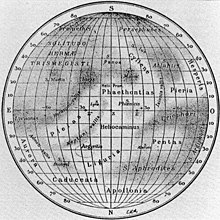Eminescu quadrangle


The Eminescu quadrangle (H-9) is one of fifteen quadrangles on Mercury. It runs from 216 to 288° longitude and from -25 to 25° latitude. Named after the Eminescu crater, it was mapped in detail for the first time after MESSENGER entered orbit around Mercury in 2011. It had not been mapped prior to that point because it was one of the six quadrangles that was not illuminated when Mariner 10 made its flybys in 1974 and 1975. These six quadrangles continued to be known by their albedo feature names, with this one known as the Solitudo Criophori quadrangle.[1][2]
An unnamed, highly modified impact basin is thought to exist to the southwest of the Caloris basin (at 6.5° N, 134.8° E). The basin is referred to as b40 in scientific literature and it is primarily recognized on the basis of a ring-shaped set of wrinkle ridges with a diameter of 310 kilometers.[3] The western rim of this basin is named Arquipelago Rupes.[4]
Derain quadrangle is to the west of Eminescu quadrangle, and Tolstoj quadrangle is to the east. Hokusai quadrangle and Raditladi quadrangle are to the northwest and northeast, and Debussy quadrangle and Neruda quadrangle are to the southwest and southeast.
Major Features
[edit]-
Exaggerated color view of Eminescu crater
-
Manley crater
-
Caravaggio crater
-
Apārangi Planitia and Faulkner crater
-
Exaggerated color view of Hafiz crater with unnamed dark crater near center
-
Unnamed crater with prominent central peak that is a dark spot[5]
References
[edit]- ^ "1:5 Million-Scale Maps of Mercury". Gazetteer of Planetary Nomenclature (USGS/IAU/NASA). Retrieved 2013-09-19.
- ^ "SP-423 Atlas of Mercury". NASA. p. 21. Retrieved 2013-09-19.
- ^ Fassett C. I.; Head J. W.; Baker D. M. H.; et al. (2012). "Large impact basins on Mercury: Global distribution, characteristics, and modification history from MESSENGER orbital data" (PDF). Journal of Geophysical Research. 117 (E12). Bibcode:2012JGRE..117.0L08F. doi:10.1029/2012JE004154. Archived from the original (PDF) on 2013-01-29.
- ^ "Arquipelago Rupes". Gazetteer of Planetary Nomenclature. IAU/NASA/USGS. Retrieved 22 August 2023.
- ^ Zhiyong Xiao, Robert G. Strom, David T. Blewett, Paul K. Byrne, Sean C. Solomon, Scott L. Murchie, Ann L. Sprague, Deborah L. Domingue, Jörn Helbert, 2013. Dark spots on Mercury: A distinctive low-reflectance material and its relation to hollows. Journal of Geophysical Research Planets. doi.org/10.1002/jgre.20115






![Unnamed crater with prominent central peak that is a dark spot[5]](http://upload.wikimedia.org/wikipedia/commons/thumb/6/68/Dark_spot_51_crater_MESSENGER_WAC_IGF_to_RGB_1.jpg/120px-Dark_spot_51_crater_MESSENGER_WAC_IGF_to_RGB_1.jpg)